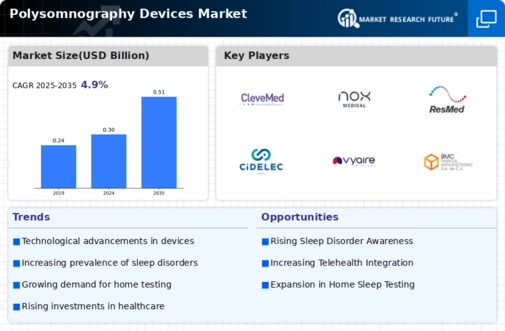Market Trends
Key Emerging Trends in the Polysomnography Devices Market
The polysomnography devices market is undergoing significant changes that mirror the evolving sleep diagnostics landscape and rising awareness about sleep disorders. The most vital of these changes is a marked increase in global prevalence of sleep-related ailments. As awareness about the effects of sleep on general well-being among individuals continues to grow, there has been a constant growth in demand for polysomnography devices employed in conducting sleep studies. Due to the increased importance placed by healthcare providers and the public alike on early detection and treatment of sleep problems this trend is developing.
Technological advancements within the Polysomnography Devices Market are significant drivers for trends in this industry. These include advanced sensors, wireless connectivity, and user-friendly interfaces that have boosted performance and accuracy levels in these gadgets used for diagnosing sleep disorders. This has also led to an emphasis on portable home-based polysomnography devices so as to facilitate easy access at minimal costs during the study periods. These technological developments align with broader trends focusing on patient-centric health care solutions.
Also importantly, there has been an upsurge in cloud-based data management solutions for polysomnography devices within this market. To store, analyze or share sleeping data as a healthcare provider you will require cloud technology. In so doing, you can achieve both remote monitoring capabilities which ideally are aimed at providing timely interventions along with real time recommendations based upon patients’ actual sleeping patterns.
In addition, another remarkable trend is integration of artificial intelligence (AI) and machine learning algorithms into polysomnography devices leading to automation of data analysis hence accurate identification of sleep disorders with more efficiency. AI powered artifacts have large datasets analyzed quickly thus enabling informed decisions making by healthcare providers who tailor individual’s treatment plans accordingly.
Besides that, fact, the Polysomnography Devices Market is seeing an increasing focus on home-sleep testing too. Patients being diagnosed using home-sleep testing polysomnograph may get better results because they can sleep in their own beds. Test at home is convenient and increases compliance to sleep diagnostics as it overcomes some of the problems related to traditional studies done in clinics.
Furthermore, as market trends evolve, there are increased collaborations between device manufacturers and healthcare providers. When partnerships and collaborations for example are formed between such organizations, research and development efforts are facilitated thereby producing more advanced, user-friendly polysomnography devices. This cooperative strategy ensures that the market remains vibrant and responsive to changes in sleep medicine’s demands.
There has been an increasing number of initiatives aimed at integrating sleep tracking features into wearable devices as a result of growing awareness on the health implications of sleep. This trend transcends conventional polysomnography devices since people now use smartwatches among other wearable technologies to monitor their sleeping patterns at home hence making them part of daily living. Thus, this consumer-driven demand for sleep tracking is shaping the industry by making it produce more compact and accessible diagnostic solutions for those who have trouble getting enough sleep or any other ones with similar issues.













Leave a Comment